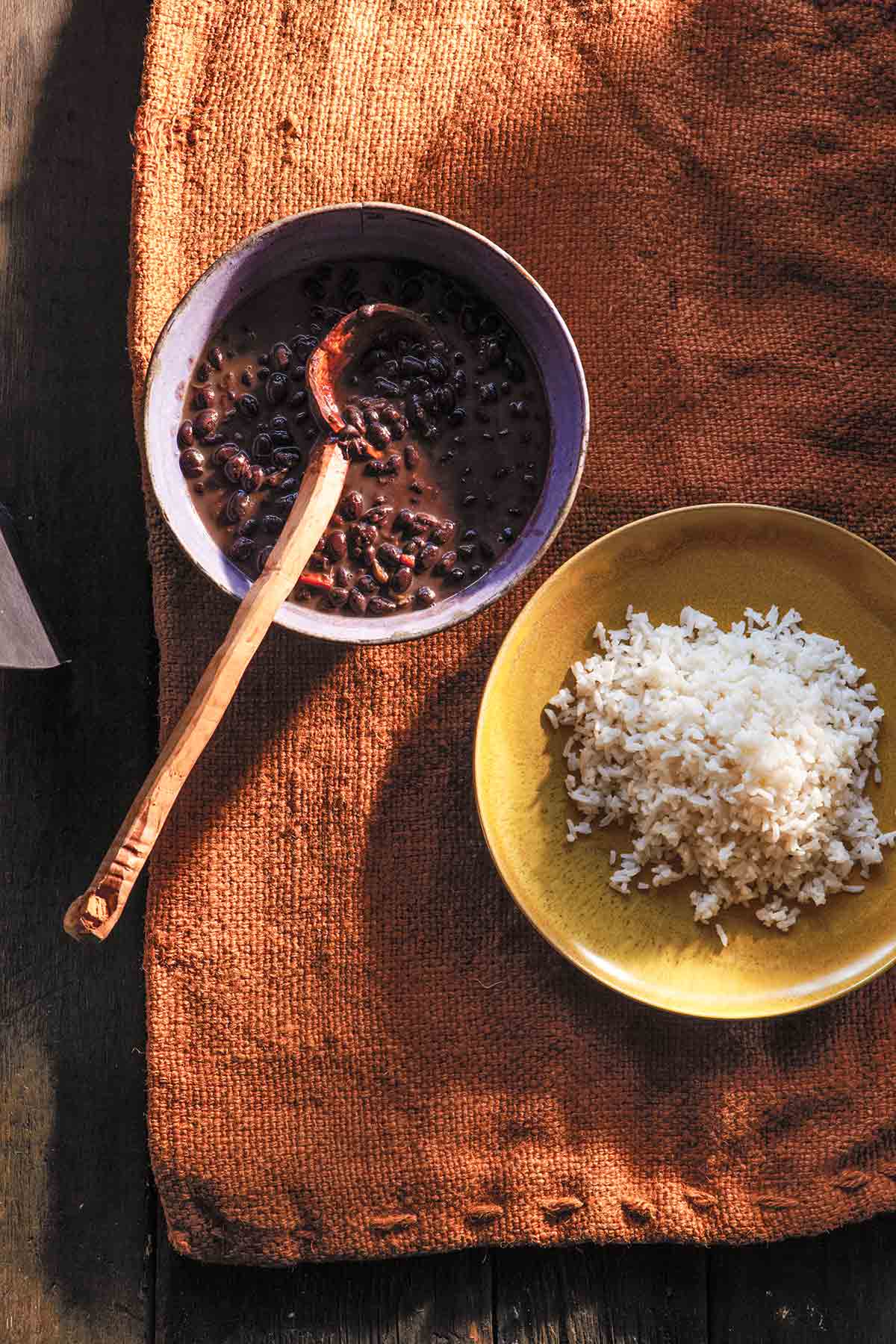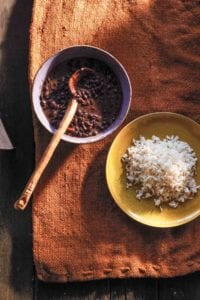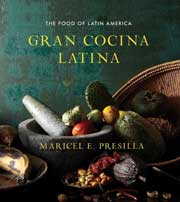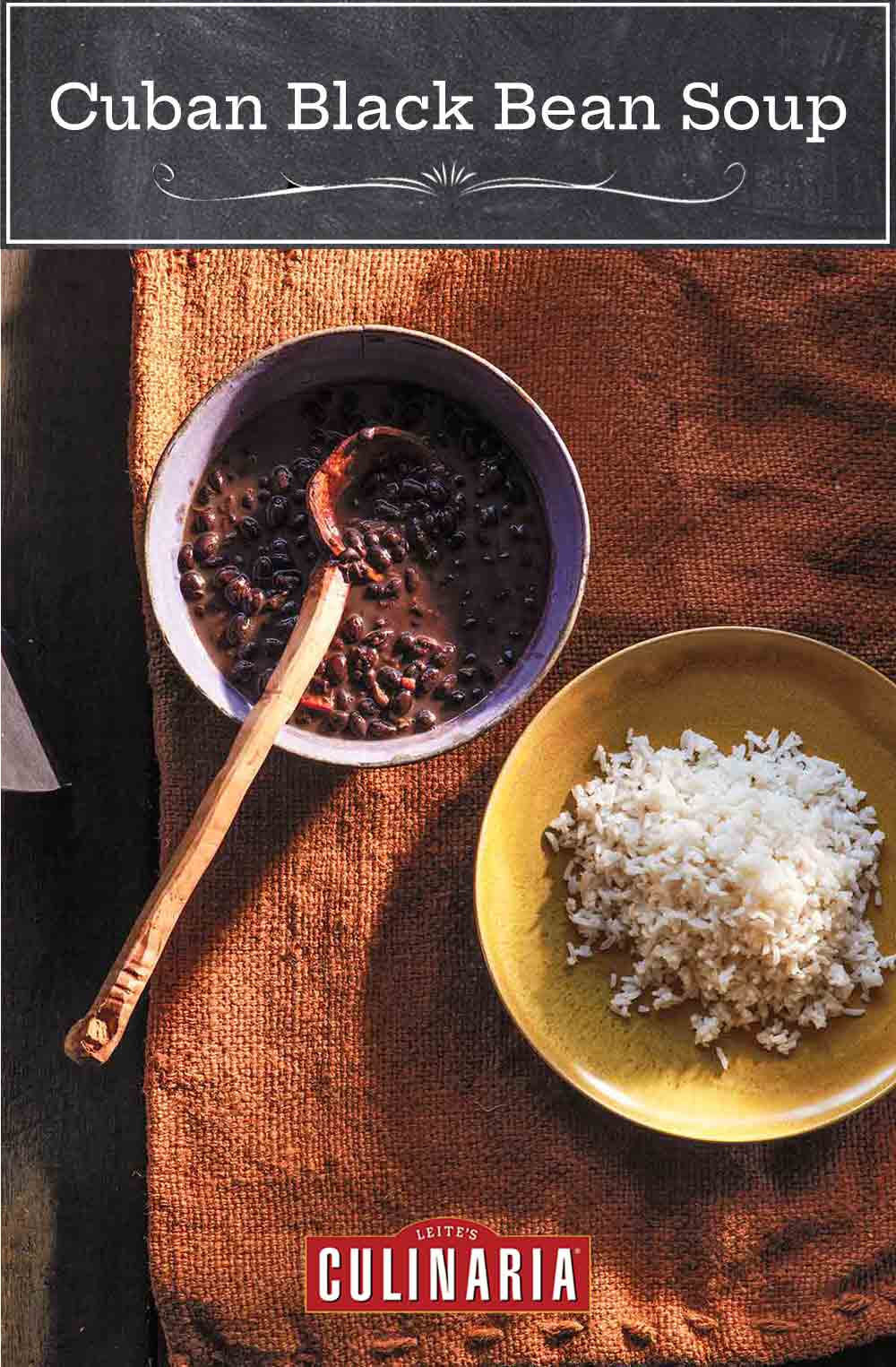
I was studying medieval history at the University of Valladolid, and my family in Miami had sent me a few pounds of dried black beans, which are not easy to find. I decided to surprise some good friends from Havana and make black bean soup, one of the great dishes of their hometown. To my bewildered embarrassment, they proceeded to set me straight: “Never, never, never do you use tomatoes in a Havana black bean soup.” And never, never, never did I forget the lesson. The soup sometimes gets some of its deep flavor from ham hocks or bacon, but many Cubans prefer to make simpler, but equally flavorful, vegetarian versions.–Maricel E. Presilla

Cuban Black Bean Soup
Ingredients
For the beans
- 1 pound (2 cups) dried black beans, picked over and rinsed
- 3 quarts (12 cups) cold water
- 1 small (6 oz) yellow onion, peeled
- 1 small (4 oz) green bell pepper, cored and seeded
- 1 bay leaf
For the sofrito
- 1/4 cup extra-virgin olive oil, plus more for serving
- 4 large garlic cloves, finely minced
- 1 small (6 oz) yellow onion, peeled and minced
- 1 medium to large (8 oz) green bell pepper, cored, seeded, and minced
- 10 Caribbean sweet peppers (ajíes dulces) or 1 Cubanelle pepper, seeded and finely chopped
- 1 bay leaf
- 2 teaspoons ground cumin
- 2 teaspoons dried oregano
To finish the soup
- 1 tablespoon red wine vinegar
- 1 1/2 to 2 teaspoons salt, or to taste
- 1/2 teaspoon freshly ground black pepper, or to taste
- 2 teaspoons granulated sugar
- 1 large red bell pepper, fire-roasted, peeled, seeded, and finely chopped (optional)
Instructions
Cook the beans
- Place the beans, water, onion, green pepper, and bay leaf in a 6-quart heavy pot and bring to a boil over high heat. Lower the heat to medium and simmer until the beans are tender, 1 1/2 to 2 hours, adding more water if necessary as the beans cook. The soup should be brothy yet creamy. (Cooking beans is not an exact science so check the water often.)
- Discard the onion, pepper, and bay leaf and lower the heat to medium-low. Ladle about 1/3 cup beans into a bowl and mash them with the back of the ladle or a spoon into a coarse purée and set aside. Keep the soup at a simmer while you make the sofrito.
Make the sofrito
- Heat the oil in a heavy skillet over medium-high heat. Add the garlic and sauté until light golden, about 20 seconds. Add the onion, green pepper, Caribbean peppers, and bay leaf and sauté for 5 minutes, or until the vegetables are softened. Add the cumin and oregano and cook, stirring, for 1 minute. Stir in the reserved mashed black beans and cook for 1 minute. Remove from the heat.
Finish the soup
- Stir the bean-enriched sofrito into the pot of beans, then stir in the vinegar, salt, pepper, and sugar. Taste and correct the seasoning if necessary; the soup should be aromatic with sweet, tangy notes. Add the chopped roasted pepper, if using. Keep the pot over medium-low heat, cover partially, and simmer until creamy, 30 to 45 minutes.
- Remove the bay leaf and ladle the soup into bowls. If desired, plonk the bottle of olive oil on the table and invite everyone to drizzle some over the soup. (The soup tastes even better the day after it’s made. Let it cool and then cover and refrigerate. Reheat at a very gentle simmer. The soup can also be frozen for up to 3 months so you may want to double the recipe.) Originally published March 13, 2013.
Notes
HOW TO SERVE CUBAN BLACK BEAN SOUP LIKE THEY DO IN CUBA
Cubans tend to serve this soup alongside or on top of white rice. A dollop of homemade Mexican or Central American crema or some chopped white onion and parsley or cilantro wouldn’t be a terrible addition.
Nutrition
Nutrition information is automatically calculated, so should only be used as an approximation.
Recipe Testers’ Reviews
I love bean soups of all types, but this Cuban black bean soup is in a whole different category. Earthy and full of subtle flavors, the vegetables in the bean broth play perfectly against the vividness of the sofrito. Every ingredient has a role; nothing upstages anything else.
I used an Anaheim pepper instead of the Caribbean sweet peppers, which added the tiniest bite. I served it with chunks of avocado on top. I bought twice the amount of dried beans necessary, so I can make another batch soon. I’m also going to try freezing it. This’d be a great dish to have on hand.
I loved this Cuban black bean soup! I struggled with not putting any meat in the soup for flavoring; however, in the end I followed the recipe exactly and I found that the flavors were really very good. This is an excellent Cuban recipe and one that I’ll definitely make again.
After tasting the soup, I found that I needed to use the full 2 teaspoons of salt. I also opted to add a little more red wine vinegar, about a teaspoon, to get that “tangy” quality (I really like vinegar in my beans). I found that as the dish cooked uncovered, a lot of my water had cooked off by the time the beans became “creamy,” as the recipe states. It was still very good, but wasn’t soupy and couldn’t be ladled as the recipe states.
Perhaps at some point the recipe should direct us to cover the beans? Or to add a little water/vegetable broth if the beans begin to thicken? The beans were even better the next day. I added some additional water to loosen them up and they were perfect.
This Cuban black bean soup is one finger-licking-good, stick-to-the-ribs, cold-weather soup. Just so simple and easy to put together, especially if you have a pressure cooker.
I’ve always cooked my beans in a pressure cooker, so I did the same for this recipe. I soaked 2 cups of black beans overnight, about 8 hours. Then I washed and drained the beans. This gave me about 4 3/4 cups of soft, plump beans. In a pressure cooker I combined the beans with the onion, bell pepper, and bay leaf, added 10 cups of water and a pinch of baking soda, and pressure cooked it. The high pressure built up in about 10 minutes and then I lowered the heat to medium-low and cooked it for an additional 15 minutes. I turned off the heat and let the steam slowly escape on its own, about another 20 minutes.
While the beans were cooking I prepared the sofrito as directed, which took about 15 minutes. I used 2 jalapeños instead of the Cubanelle and this imparted a nice bite and flavor to the soup. Once the pressure cooker was ready to be opened, I took out 1 cup of the cooked beans and mashed them, saved a couple of cups of the cooking liquid, and discarded the pepper, onion, and bay leaf.
Daughter and I loved this; hubby thought there was a bit too much bell pepper for his taste, though he still liked it. I thought all the flavors in this soup came together perfectly. It was the perfect winter Sunday supper. We had ours with some cornbread, which complemented it nicely.
I couldn’t find Caribbean or Cubanelle Peppers and my store didn’t even have an Anaheim, so I used a red bell. I didn’t use the optional fire-roasted pepper nor the drizzle of olive oil. Next time I’ll use a little less bell pepper.
This is an almost perfect black bean soup recipe. For me it worked on all levels: it was easy to make and delivered a robust earthy flavor. I made it to go along with some Cuban-style spareribs and of course it was a perfect match for the rich pork.
The recipe requires no soaking for the beans either and that is another plus, so it doesn’t have to be started the night before. On the other hand it kept getting better as it sat in the fridge. I prefer a slightly more assertive tartness in the soup. So I used a bit more red wine vinegar, about 3 tablespoons. Only mixing in a 1/3 cup of mashed beans didn’t make it as thick as I like. I mixed in about a whole cup. This gave it a texture closer to a thin chowder. Again, this is a personal preference on our behalf.
Even if serving the soup as a main course, this’ll easily feed 6 people minimum. As a side, probably up to 10. No Cubanelle or Caribbean peppers in my grocery store, so I used a medium red bell pepper with good results. The red color flecks in there looked very attractive as well. I know the recipe says the roasted red bell pepper to finish the soup is optional, but in my opinion it’s one of the touches that takes this recipe to a slightly higher level than other black bean soups. It adds a great sweet and roasted flavor that works very well.
A perfect January-in-Chicago soup! I made this for a vegetarian potluck with primarily nonvegetarian attendees. No one commented on the lack of ham hocks or bacon, and the soup was enjoyed by vegetarians and non-vegetarians alike.
I started one step further back than the author begins: to save time, I presoaked the beans for 12 hours before beginning to cook them. It takes so little effort to presoak and it decreases the cooking time. I’ve also heard beans are healthier and more digestible when prepared this way. I used the optional roasted red pepper, and seasoned the soup plentifully with red wine vinegar and black pepper.
Doubling the recipe made for a soup course that served more than twice the 8 to 12 servings stated. And, yes, this is terrific for leftovers; it was indeed, as stated, better the second day. And, yes, rice is nice here. Soup on rice, rice on soup, soup in a bowl and rice on the side—all are variations on the theme of black beans and rice that works so successfully here. This soup calls out for rice and feels complete when the two are served together.
I really enjoyed what the sweet and tangy flavors from this soup. Even though I soaked the beans overnight, I found that it required another 2 hours and 25 minutes of cooking to get them tender.
I also used one Cubanelle pepper in the recipe. This is a great basic black bean soup, and I didn’t miss the tomatoes. Served over quinoa, this was a filling, meatless meal that was perfect for a cold winter day. Don’t be discouraged by the total prep time, as most of that’s simmering time.
I wasn’t at all sure about this Cuban black bean soup, as we usually use meat of some kind in bean soups, like a couple of ham hocks. But I made it as is, using an Anaheim pepper in place of the Caribbean peppers. I simmered it for the full 2 hours and the beans were tender but not falling apart. I added the sofrito and thought it was watery. I refrigerated it overnight and then continued simmering it for another hour or so and that made a great difference. I did add the roasted pepper, and served it over some rice with a patty of chorizo and a dollop of crema. That definitely added to the soup. Next time I’ll use a ham hock or bone.
This was a great-tasting Cuban black bean soup for not having any meat in it!
I had to cook the beans for 3 to 4 hours, not 1 1/2 to 2 hours as the recipe suggested, but the notes did say that cooking beans isn’t an exact science. I used a red bell pepper instead of the Caribbean pepper in the sofrito. The sofrito added a layer of flavor but the red wine vinegar, sugar, and roasted red pepper at the end really made it so much better. Everyone loved this soup! I’d make this again but tweak it a bit, adding fresh lime juice and jalapeño peppers to give it a kick.
What a satisfying soup for your taste buds and tummy. The sofrito made the soup very flavorful (hard to believe it’s vegan), and the red wine vinegar and sugar added more layers to be enjoyed. But none of them overpowered the black beans—the main star of the dish.
I cooked the beans uncovered the first 2 hours, and partially covered the last 30 minutes since the beans were getting pretty thick and I didn’t want them to dry out. The creamy and dense soup would make a very filling (and super economical) meal especially if you choose to serve it with rice. Next time I’ll skip the mashing and adding of some of the beans to the sofrito; the step seemed unnecessary.
I’ve committed to spending a good part of the week eating meatless, and a standard way of keeping protein levels appropriate at the table is to serve beans and rice together. So on my radar now are recipes that reflect authentic foodways that use this approach in a delicious way. I’ve made black bean soup recipes before but they seemed to have missed the key elements this recipe finishes up with, mainly the sweet and sour (sugar and vinegar).
I added an additional 1 tablespoon of red wine vinegar at the end for a bit more acidic balance.
How wonderful and comforting this soup is alongside some warm, fluffy white rice. I didn’t miss the meat at all and I encourage you to add this recipe to your repertoire. The leftovers go far and do indeed become more delicious the next day.
Okay, so this is Cuban black bean soup an involved recipe in the sense that you have to cook each part separately and no shortcuts are suggested. However, the resulting soup is so good that you won’t regret it. The flavor was really good.
I did substitute a yellow bell pepper for the Caribbean sweet peppers. So I didn’t use the additional (optional) red bell pepper later on. I’d try substituting canned beans and modifying the sofrito to make it faster for a weeknight meal.


















I LOVE Cuban Black Bean Soup!
When I make it I cook my dried beans in a pot with a smoked hammock first. Then I go on to finish the soup s-l-o-w simmering the beans and most of the sofrito until it gets thick. Depending on the beans I start with this can easily be a 2-day process but soooo worth the time. The flavors that time develops are rich and earthy and sublime.
I also think the vinegar is really a very important ingredient. I use a mature flavorful one that I’d sip from the bottle. In fact, the truth is I’m an odd duck that prefers the flavor of vinegar to wine and I actually do sip it if it’s good and don’t buy it if it ain’t worth sipping.
I’ve never had access to Cuban peppers so I have to resort to bell peppers but, even lacking that authenticity I think this is a delicious and comforting soup that more Americans should be familiar with.
Thanks, Rainey. I’m with you all the way on buying the best quality vinegar you can find. It’s definitely worth it!
Can I sub red peppers for the green? My system doesn’t tolerate the green peppers very well.
Absolutely, Diane!
I spent years in Key West and Miami where black bean soup is always on the menu somewhere. I think this recipe is great and can be added to suit oneself.
Lovely to hear Ardell, thank you!